Abstract
The high penetration rate of renewable energy sources (RESs) in smart energy systems has both threat and opportunity consequences. On the positive side, it is inevitable that RESs are beneficial with respect to conventional energy resources from the environmental aspects. On the negative side, the RESs are a great source of uncertainty, which will make challenges for the system operators to cope with. To tackle the issues of the negative side, there are several methods to deal with intermittent RESs, such as electrical and thermal energy storage systems (TESSs). In fact, pairing RESs to electrical energy storage systems (ESSs) has favorable economic opportunities for the facility owners and power grid operators (PGO), simultaneously. Moreover, the application of demand-side management approaches, such as demand response programs (DRPs) on flexible loads, specifically thermal loads, is an effective solution through the system operation. To this end, in this work, an air conditioning system (A/C system) with a TESS has been studied as a way of volatility compensation of the wind farm forecast-errors (WFFEs). Additionally, the WFFEs are investigated from multiple visions to assist the dispatch of the storage facilities. The operation design is presented for the A/C systems in both day-ahead and real-time operations based on the specifications of WFFEs. Analyzing the output results, the main aims of the work, in terms of applying DRPs and make-up of WFFEs to the scheduling of A/C system and TESS, will be evaluated. The dispatched cooling and base loads show the superiority of the proposed method, which has a smoother curve compared to the original curve. Further, the WFFEs application has proved and demonstrated a way better function than the other uncertainty management techniques by committing and compensating the forecast errors of cooling loads.
1. Introduction
In the modern power system, there is a fast-growing rate in both supply/demand sides, which is the most considerable on-board problem for the system operators. First of all, at the supply side, on the basis of the green energy contracts, renewable energy sources (RESs) are to tackle the climate crisis in the green energy viewpoint [1]. Considering the benefits of the RESs and their promising opportunities for the energy systems, the penetration level of RESs is rising rapidly. Second, at the demand side, the thermal energy storage system (TESSs) is well designed to commit the cooling/heating consumption units in the urgent time spots, when the system cannot provide the loads sufficiently because of generation problems. Individually, the commercial and industrial consumption sectors have a larger volume of thermal demands. Considering the former units provided by the TESSs, the operation problem of the system would be totally relaxed. Considering the mentioned fact, utilizing RESs is helpful for the system, and PGOs are willing to practice TESSs in the system. In addition, demand response programs (DRPs) are an example of other practical approaches that have been applied in the power system. Basically, the DRPs are to shift a part of the load from one time interval to another. This means committing the consumption units at another time instead of peak time. In this regard, DRPs are more applicable for the thermal consumption units as the comfortability of users would be remained after the interruption of supply for a few hours.
Uncertainty management in RESs is a widespread and useful technique for system operators to decrease the total cost of the system. To do so, the operators try to forecast the uncertain data of the system a day before. Therefore, using all the forecasting methods is useful and effective, but still there is a long process to go through and there is a variety of forecasted errors for the system operators, e.g., whether the real data are greater than the forecasted data or less. In this regard we have to deal with these forecast errors in a fine way to stay in the optimal condition. The error between the forecasted data and the actual data of wind farms, the so-called wind farm forecast error (WFFE), has been a controversial debate among researchers so far. Considering the WFFEs, the system will become complex to handle. Moreover, the optimal scheduling of such a complex system is the operator’s objective. The difference between the forecasted and actual data of the WFs makes the problem hard to solve optimally [2,3]. To deal with such an issue, scientists have developed some solutions. WFFE is one of the newly introduced approaches that is based on the real-time compensation of the errors. Generally, as the day-ahead value of the WF is yet uncertain, but the real-time values are predictable 15 min ahead, there is an opportunity to compensate the system in real-time operation.
Generally, energy storage technologies are effective solutions to tackle the WFFEs in real-time operation. The TESSs not only compensate these errors, but also add much flexibility to the system [4]. This is why the PGOs are willing to utilize the TESSs. Moreover, because of the significant amount of installed TESSs in the industrial and residential areas, the storage systems are so suitable to use in such strategies. To this end, the optimal operation of TESSs in the power system is formulated in the literature, which would be helpful for the operation of the power grid [5,6,7,8].
DRP is a new definition in power systems, which is so appealing due to its applications in the energy systems operation. In that way, the PGOs are so willing to use the DRPs in the system operation [9,10]. Furthermore, the DRPs have been evaluated on all energy sectors, including industrial, residential, and commercial loads. The application of DRPs is not restricted to electrical loads, and it could be practiced on other types of energy demands, such as thermal loads, as well [11,12]. Therefore, it would be exciting to analyze the effect of DRPs on thermal consumption units. Obviously, thermal loads use electric power directly to produce the desired cooling effect, for which we could have an indirect impact on the electrical power by controlling the cooling demand. In this study, and therefore the former applications studied in [2], the aim is to analyze the DRP programs on thermal loads.
The main contributions of the paper are as follows:
- The feature of WFFE has been investigated from a new perspective, which will give a better dispatch of the TESS capacity level. In contrast with the other works, the WFFE has been applied instead of considering uncertainties to analyze the differences between forecast and actual wind data.
- The day-ahead and real-time operations are considered for an A/C system considering WFFEs. At first, the day-ahead operation is calculated, and then the real-time operation is performed. The WFFEs in the day-ahead operation are compensated in the real-time operation utilizing the TESSs.
- DRPs are employed for managing the cooling loads to make the consumption curve smoother. As mentioned so far, DRPs are more sensible for thermal loads against electric loads. Using the DRPs for cooling loads, there is more space in the TESSs to compensate for the WFFEs in real-time operation.
2. Material and Methodology
The general algebraic modeling system (GAMS) is a well-known tool for solving complex optimization methods that employ several solvers to obtain optimal set points of the problem. Various optimization problems, including linear/nonlinear problems, can be solved using GAMS. The presented scheme for the air conditioning system and TESS in this study is a nonlinear model, which is handled by GAMS software applying CONOPT solver [13,14]. CONOPT is a known GAMS solver for dealing with complex nonlinear problems, which has a high rate of efficiency and reliability for a vast class of optimization problems. Such a solver of the GAMS software includes a rapid approach in obtaining a first feasible solution, which is appropriate for problems with few freedom degrees. The CONOPT uses an optimization methodology based on the generalized reduced gradient (GRG) method that is introduced by Abadie and Carpentier. The actual implementation has many modifications to make it efficient for large models and for models written in the GAMS language. The main levels in the GRG method are provided in Figure 1 [14].
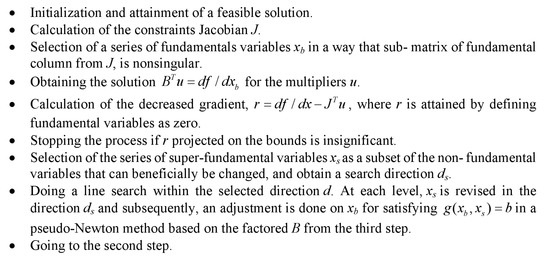
Figure 1.
The optimization methodology used in this research for obtaining optimal set points of the system equipment.
3. Problem Formulation
3.1. Features of Wind Farm Forecast Errors
Due to the uncertain nature of wind farm productions, tackling these uncertainties in a proper way is a challenging issue. Both the vision of the individual system operator (ISO) and the facility owner will face such issues. On the one hand, by hindering these uncertainties, the ISO can easily handle and manage the network; on the other hand, when these uncertainties become less, the owner gets a higher profit. This means that it would be a win–win strategy for both the ISO and owner to tackle these uncertainties.
In different studies, various models are presented to model these uncertainties such as robust optimization [15,16,17], stochastic programming [18,19,20], and the information gap decision theory (IGDT) approach [21]. These methods only model and analyze the volatilities, and in the real world we need proper solutions to handle such issues. In this regard, WFFE is a propitious approach to compensate for the forecast errors. Furthermore, by pairing TESSs, which have the ability to store energy at off-peak hours and discharge it to the system at on-peak hours, the performance of the system would be entirely promising. In this study, the authors have proposed such a strategy to tackle the WFFEs.
() is the real forecast errors and () is the relative forecast errors, which are modeled as follows.
The day-ahead forecasted wind farm production is defined by , and the day-ahead actual wind production is . The day-ahead forecasted wind farm data has been considered as the base parameter as it is the only known parameter in the day-ahead scheduling.
3.2. Wind Energy Forecast Errors Characteristics
WFFE is a new concept, which is described in this part. The following parameters have been presented to calculate the parameters of the WFFEs.
First, two parameters used for WFFEs model are the upward/downward wind WFFE, which are presented as follows.
Here, the numbers of operation time slots are equal to 96 intervals, which is 15 min per time step. The relative positive/negative parameters of wind farm energy forecast errors are calculated in Equations (5) and (6).
A complete chart of the day-ahead and real-time operating model of the proposed system is demonstrated in Figure 2. First, the model studies day-ahead operation and then at the present day. After the calculation of the WFFEs, the real-time operation will be performed for compensating forecast-errors.
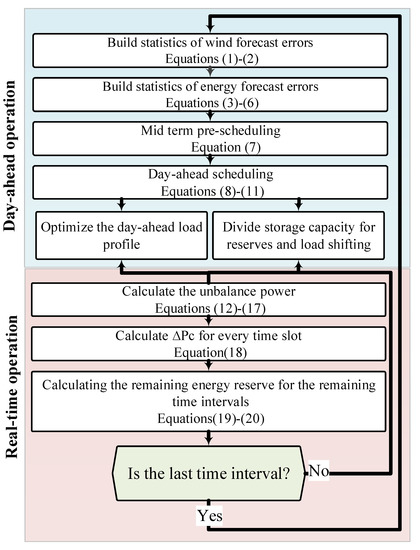
Figure 2.
Complete flowchart of day-ahead/real-time operation of the proposed system.
Further, both day-ahead and real-time scheduling details are completely discussed at the rest of the paper.
3.3. Day-Ahead Operation
In the day-ahead operation part, the problem is solved at all time intervals a day before using the forecasted data. First of all, the upward/downward energy reserves of the TESSs should be determined, which are the and values in Figure 3. These parameters should be evaluated by using the wind farm forecast data. The day-ahead forecasted wind farm production data of the wind farm is attained using
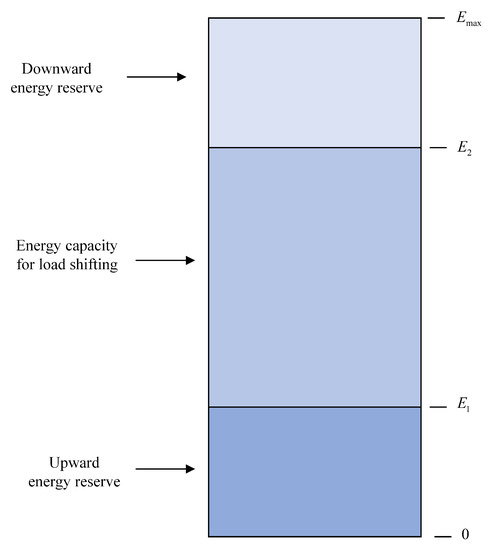
Figure 3.
Capacity level of thermal energy storage systems (TESSs).
The TESSs should take at least 25% of the highest value of forecast-error data, which has been calculated in the pre-scheduling part of programming process. Similarly, upward/downward scheduled reserves should be at least 25% of the data of Table 1 related to the output level of the next day wind farm forecast production. All storage systems are scheduled to provide some part of reserve considering their capacity level. Accordingly, and should be determined for all storage systems. Furthermore, by performing the mentioned levels, the cooling demand can be well scheduled for use in load shifting as follows.
subject to:

Table 1.
Upward/downward energy forecast error coefficients at different cases.
is the cooling power variable of unit i at time slot t, that is, the main variable to control the objective. is the cooling demand parameter of the air handling units. The variable electricity base-load is , which consists of whole load units except cooling demand. Nt is total number of time slots in a proposed day and Ns is the TESSs number. The objective is minimizing the total load consisting of cooling power and base-load in the objective function by a quadratic objective. Furthermore, based on this methodology, the most preferred demand curve will be provided, which aims at minimizing the demand peak and maximizing demand valley. Equation (9) demonstrates the flexibility level added by the TESS to the system. As shown before in Section 3.2, differences between and are covered by the charge/discharge power of the TESSs. The capacity level of the proposed TESSs for the load shifting in the day-ahead programming is the values of and . The initial state of charge (SoC) of the TESSs is equal to . The limitation of cooling power, which means max/min rated power, is presented in Equation (10). Equation (11) presents an equality constraint between cooling power and the demand of the system over all time slots, which discloses the load shifting possibility at each time period.
3.4. Real-Time Operation
The main target of real-time scheduling progress is to calculate the real-time differences between forecasted and actual data by using the TESSs to compensate for the WFFEs. As a matter of fact, the upward/downward reserves of the TESSs are considered to be available for covering the WFFEs up. At the start of every time spot, the remained upward/downward reserve is circulated to the remained time spots of that day due to the probability of WFFEs at each time spot. The expected conditional negative/positive forecast-errors of the considered time can be modeled by the following weighting coefficients (Equations (12) and (13)).
The relative probability density of the forecast errors is modeled through while the output level of the storage is mid. The weighting factors of all five output levels of wind production are listed in [2].
In addition, as the forecast error for the running time slot is determined, the weighting factor can be computed in a different way based on Equations (14) and (15):
In Equations (14) and (15), represents the ongoing time slot, and are the primary weighting coefficients gained from the work in [2], and is the present forecast error. Accordingly, if is large enough, the should be chosen. The value of discloses that while the value of forecast data is large, the storage unit should, at least, take 25% of its capacity, as it has been proposed in the pre-scheduling term. If is not as large as it used to be, the primary weighting coefficient should be chosen, as the storage may compensate extra forecast errors if they are originally small. Referring to the calculated weighting coefficients, the energy reserves for the ongoing time spot can be defined as Equations (16) and (17),
where and are the surviving upward/downward reserves of the current day, respectively, which is the same as the optimized reserves minus the used energy reserves at past time slots. The assigned energy reserves curtail the power adjustment at this time slot.
can be calculated by using Equation (18):
where is entirely determined by the errors of wind farm forecast, the energy level curtailments, and the power capacity curtailment.
By applying the power modification at the ongoing time slot, the energy capacity will be updated through Equations (19) and (20):
It should be noted that if , the storage will be charged, the downward energy reserve will be reduced, and the upward energy reserve will be increased. The condition would be reversed if .
By applying this approach, the reserves are earmarked to every time spot by the anticipation of the WFFEs. Likewise, if fewer energy reserves are employed initially in the day, more improvements could be enabled later in the day. This helps in the practical use of the reserves in real-time engagement.
4. Results
4.1. The Proposed System and Its Data
A simple local energy system has been considered as a proper test system in this case, which consists of a commercial zone with a 110 kV power station. The considered commercial region includes ten huge commercial buildings with air handling units, for which the system schematic has been depicted in Figure 4. Moreover, the rated power and total capacity of all TESS are 1.5 MW and 13.5 MWh, respectively. The total capacity of all TESS is 4.5 MWh from an electricity viewpoint, considering that the coefficient of A/C storage performance almost 3.0. The TESSs will take 135 m per 100 kWh, and the density of the A/C storage will determine its size. The system size can be decreased by utilizing a proper TESSs [22,23], as the size of TESSs should be acceptable for that huge commercial buildings. In addition to the ten buildings, some additional demands consisting of all energy demands except cooling demands are also considered, which have made a total peak load of the system equal to 80 MW. In order to simulate those additional loads, a typical load profile is studied. The considered typical load profiles for the base-load and cooling loads are shown in Figure 5. As mentioned before, the main focus of the current work is wind forecast errors, and the errors in loads are entirely neglected.
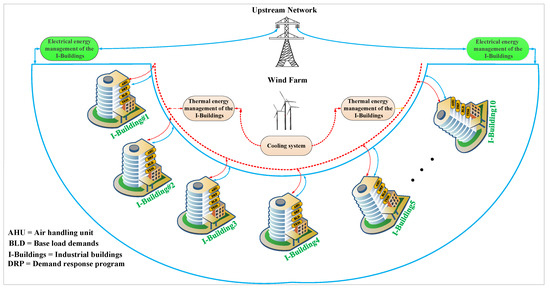
Figure 4.
The schematic of the proposed industrial area.
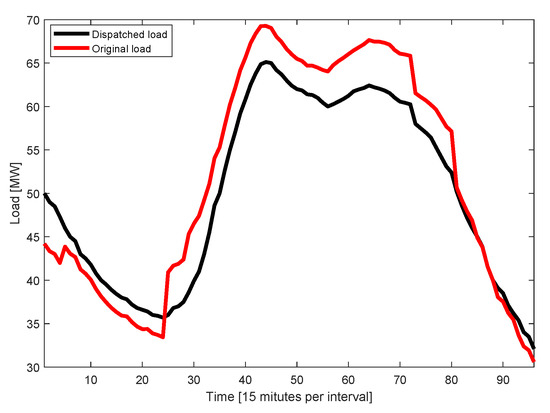
Figure 5.
Baseload in original and dispatched shape.
The other important contribution of the current study is the application of demand response programs for flexible cooling loads. The demand response phrase is new in the power system, which has been considered in both theoretical and practical projects on electric/thermal demands. In this regard, the demand response program has been proposed to be applied to the flexible cooling load. Additionally, Figure 6 shows the cooling demand prior and after the application of the demand response programs.
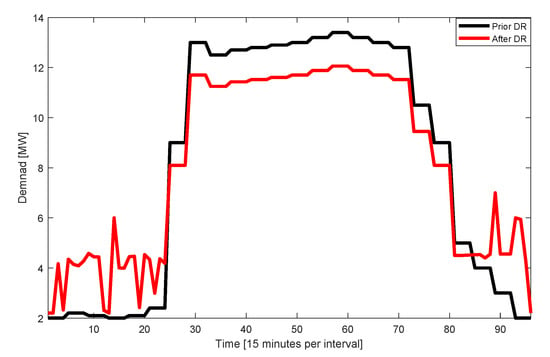
Figure 6.
Cooling load prior and after applying demand response.
The authors have considered a total capacity of installed wind equal to 20 MW that covers 25% of the whole peak load. The practical wind data are gained from TenneT over the year 2019 to use for the identification of WFFEs [23]. Two different data for the wind farm exist that include the actual and forecasted data. For the day-ahead scheduling, the forecasted data has been utilized, and actual data has been used in the real-time operation. Considering no data for a proper wind farm with 20 MW capacity, the authors have considered a wind farm with 950 MW capacity normalized to 20 MW. Because of hard accessibility to the real data, both the test system and load are theoretical. Furthermore, the proposed development design is in line with different system data or load curves.
4.2. The Day-Ahead Operation
In the day-ahead operation section, the TESSs capacity is considered to classify the forecasted wind farm production of the next day. Figure 7 shows the forecasted and actual wind data. It should be noted that the remaining TESSs capacity is used for upward/downward reserves in the real-time operation.
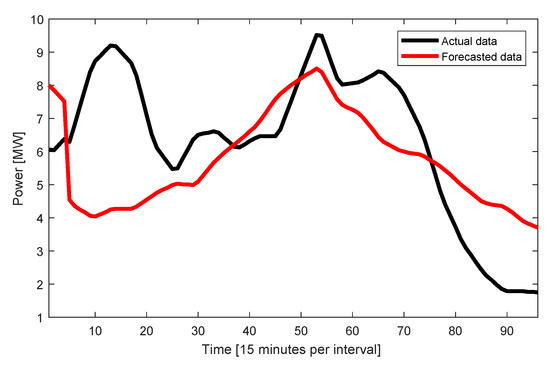
Figure 7.
Forecasted and actual wind data.
The dispatched load curve compared to the load curve prior to scheduling (i.e., the original load) for 10 April is shown in Figure 8. Wind farm power output is considered a negative term in the equality constraint. As anticipated, the TESSs consumes more power during the load curve valley, which aims to store the power to discharge it the on-peak hours. Therefore, the system will have a better load supply without any interruption that is so important for the system operator.
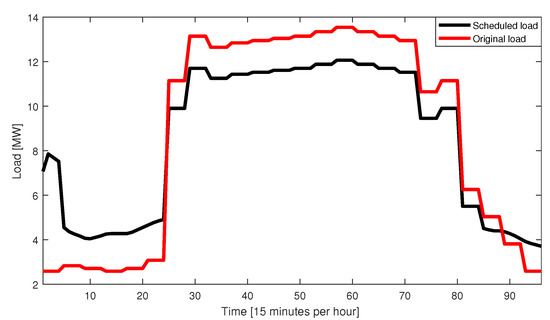
Figure 8.
Cooling demand in original and dispatched shape.
Load curve procurement is an option for power systems operators that could help to relax the operation issues. Even a small percentage reduction of the peak load value could be effective in avoiding high interval price and lots of additional investments in the power system. On the other side, the dispatched version of the original load has less variation of itself, which means a tied cure among peak and valley. Moreover, in the renewable integration approaches, the variation of the load has a deep concern for the operators, as it could heighten the uncertainty level.
The impact of load shifting is directly associated with the scheduling of TESSs. The time slots with a high value of forecasted wind farm production should allow comparatively more TESSs capacity in reserves, and less will be accessible for shifting of the load. In opposition, while the forecasted data of wind farm production is low, more TESSs capacity will be available to use for load shifting. Furthermore, as wind farm production is considered a negative part in the equality constraint, the net peak load could be higher when the wind farm production is lower. Additionally, extra TESSs capacity will be in touch to use in the load shifting process.
4.3. The Real-Time Operation
In real-time scheduling, the cooling demand is also adapted to treat WFFEs. The results of the cooling consumption units in both original and dispatched versions are depicted in Figure 8. The selected day has a big value of variation, inherently. The curve had been divided into three parts, and in the first and second parts of the day, the values of the actual data are higher than their forecasted values. This shows the potential for storing energy in the TESSs at this time intervals as well as the supply of demands in a smooth way. It could also be used for load shifting as well. In this regard, in the last part of the day, the forecasted values are higher, which means that the TESSs should be utilized to compensate the WFFE with less load shifting. The transactions in the real-time operation could be utilized for the energy reserve more actively. Comparable happenings could be shown on the other days.
The forecasted wind farm production errors are large on the considered day. In real-time operation, the proposed approach is working actively, which is capable of covering more than 75% of net forecast errors.
Figure 8 demonstrates the net cooling consumption and cooling power on the considered day. It can be seen that in the day-ahead operation, the cooling consumption is shifted from noon to the late evening considering the positive impact of DRP and TESS. In the real-time operation, using TESSs, the cooling supply is further adapted for covering the WFFEs.
4.4. Analysis
The results show that the suggested scheduling design can manage the TESS for various goals efficiently. The separation of energy capacity could impact the efficiency of each part. If extra TESS capacity was used for upward/downward reserves, the load curve would be fully corrected, and less extensibility will exist for responding volatilities in the real-time, and vice versa. In the recommended design, the capacity of TESS devices is dispatched by the probability of WEFEs. The reserved capacity of TESSs must be capable of meeting a special rate of the most significant WFFEs. The surviving capacity of TESS is used to enhance the systems load curve. The WFFEs application is more reliable than the other uncertainty management techniques since there are both negative and positive sides in the uncertain parameters. As it had been denoted, in the first two parts of the proposed day, the forecasted values of wind farm production were less than the real values and they were greater than the actual values in the third part of that day. Considering this fact, using other uncertainty modeling techniques is not effective. Using the proposed technique, not only do we optimize the system a day before, but we are also able to compensate for the errors at the present day.
In the real-time operation approach, a dynamic methodology is employed to schedule the energy reserves to meet the WFFEs. According to the outputs, the diminution of forecast errors is always higher, or close to, the designed percentage, which gives adequate support for power system operators to allow more RESs. Certainly, optimal dispatching of the TESS facilities is a current problem in power systems that needs further investigation. Additional procurement to the suggested design would be helpful because trade-offs among various aims exist.
The aimed scheduling design applies to different kinds of TESSs. The TESS is managed as an experiment problem for the incorporation of electric AC networks, for which the application of the TESS is quite promising. The current work concentrates on wind farms because the characteristics of the instabilities of different kinds of RESs could be varied. A further general structure for assessing the volatilities of the RES is feasible for future subjects.
5. Conclusions
In this paper, a scheduling model for an AC and TESS has been applied to a commercial area consisting of ten large buildings based on a recently investigated method for wind farm forecasted errors. The studied area has a considerable cooling demand. As an inevitable part of the system, the application of DRPs has been considered for the flexible cooling loads, which is more feasible in the studied case as the comfortability of the user will remain after the power collapse for at least an hour. Moreover, the daily forecast and real data of a the studied wind farm proved the importance of using WFFEs. Therefore, the uncertainty of the RESs has been considered in the other scientific papers in the day-ahead operation methods; here, we considered both day-ahead and real-time operation methods to compensate the WFFEs, which makes the responses more reliable as this way we work with the real data of the problem. The TESS is a well-known solution toward handling the uncertainties of RES has been employed to commit the cooling loads at on-peak time intervals. Considering the above-mentioned facts, to solve the subjected complex problem, a new methodology consisting of day-ahead and real-time operations was applied. The results from the presented methodology have shown a great potential of applying the TESSs and DRPs on the cooling loads. In both cooling and base loads, the committed curve is much smoother than the original curve, which makes the solution better, in optimal condition point of view. For future works, here, there could be a comparison between the WFFEs and other uncertainty management methods like robust optimization. Other DRP methods could also be enjoyed to analyze how operators could optimize the problem by managing the other side of the problem (the demand side).
Author Contributions
Methodology, B.M.-I.; software, A.D. and K.S.; validation, M.N.-H. and M.M.; writing–original draft preparation, A.D. and K.S.; writing–review and editing, M.M., S.T., M.N.-H. and B.M.I.; supervision, S.T. and M.M. All authors have read and agreed to the published version of the manuscript.
Funding
This research received no external funding.
Conflicts of Interest
The authors declare no conflict of interest.
References
- U.S. Enegy Information Administration. Available online: https://www.eia.gov/ (accessed on 30 January 2020).
- Tang, Y.; Zhong, J.; Bollen, M. Schedule of air-conditioning systems with thermal energy storage considering wind power forecast errors. Int. J. Electr. Power Energy Syst. 2018, 95, 592–600. [Google Scholar] [CrossRef]
- Wu, J.; Zhang, B.; Li, H.; Li, Z.; Chen, Y.; Miao, X. Statistical distribution for wind power forecast error and its application to determine optimal size of energy storage system. Int. J. Electr. Power Energy Syst. 2014, 55, 100–107. [Google Scholar] [CrossRef]
- Energy Storage Association. Available online: https://energystorage.org/ (accessed on 4 November 2017).
- Rosato, A.; Ciervo, A.; Ciampi, G.; Scorpio, M.; Guarino, F.; Sibilio, S. Impact of solar field design and back-up technology on dynamic performance of a solar hybrid heating network integrated with a seasonal borehole thermal energy storage serving a small-scale residential district including plug-in electric vehicles. Renew. Energy 2020, 154, 684–703. [Google Scholar] [CrossRef]
- Elhashmi, R.; Hallinan, K.P.; Chiasson, A.D. Low-energy opportunity for multi-family residences: A review and simulation-based study of a solar borehole thermal energy storage system. Energy 2020, 204, 117870. [Google Scholar] [CrossRef]
- Daneshvar, M.; Mohammadi-Ivatloo, B.; Zare, K.; Asadi, S. Two-stage stochastic programming model for optimal scheduling of the wind-thermal-hydropower-pumped storage system considering the flexibility assessment. Energy 2020, 193, 116657. [Google Scholar] [CrossRef]
- Hemmati, R.; Mehrjerdi, H.; Bornapour, M. Hybrid hydrogen-battery storage to smooth solar energy volatility and energy arbitrage considering uncertain electrical-thermal loads. Renew. Energy 2020, 154, 1180–1187. [Google Scholar] [CrossRef]
- Daneshvar, M.; Mohammadi-Ivatloo, B.; Zare, K. Two-stage optimal robust scheduling of hybrid energy system considering the demand response programs. J. Clean. Prod. 2020, 248, 119267. [Google Scholar] [CrossRef]
- Ajoulabadi, A.; Ravadanegh, S.N.; Mohammadi-Ivatloo, B. Flexible scheduling of reconfigurable microgrid-based distribution networks considering demand response program. Energy 2020, 196, 117024. [Google Scholar] [CrossRef]
- Jafari, A.; Khalili, T.; Ganjehlou, H.G.; Bidram, A. Optimal integration of renewable energy sources, diesel generators, and demand response program from pollution, financial, and reliability viewpoints: A multi-objective approach. J. Clean. Prod. 2020, 247, 119100. [Google Scholar] [CrossRef]
- Bostan, A.; Nazar, M.S.; Shafie-Khah, M.; Cataláo, J.P. Optimal scheduling of distribution systems considering multiple downward energy hubs and demand response programs. Energy 2020, 190, 116349. [Google Scholar] [CrossRef]
- Mirzaei, M.A.; Nazari-Heris, M.; Mohammadi-Ivatloo, B.; Zare, K.; Marzband, M.; Anvari-Moghaddam, A. A novel hybrid framework for co-optimization of power and natural gas networks integrated with emerging technologies. IEEE J. Syst. 2020, 1–11. [Google Scholar] [CrossRef]
- RE Rosenthal GAMS User’s Guide and Examples, USA. 2012. Available online: https://www.gams.com/ (accessed on 4 August 2012 ).
- Majidi, M.; Mohammadi-Ivatloo, B.; Anvari-Moghaddam, A. Robust operation of combined heat and power systems with demand response programs. Appl. Therm. Eng. 2019, 149, 1359–1369. [Google Scholar] [CrossRef]
- Petrollese, M.; Cocco, D. Robust optimization for the preliminary design of solar organic Rankine cycle (ORC) systems. Energy Convers. Manag. 2019, 184, 338–349. [Google Scholar] [CrossRef]
- Rahmani, S.; Amjady, N. Optimal operation strategy for multi-carrier energy systems including various energy converters by multi-objective information gap decision theory and enhanced directed search domain method. Energy Convers. Manag. 2019, 198, 111804. [Google Scholar] [CrossRef]
- Guerra, O.J.; Tejada, D.A.; Reklaitis, G.V. Climate change impacts and adaptation strategies for a hydro-dominated power system via stochastic optimization. Appl. Energy 2019, 233–234, 584–598. [Google Scholar] [CrossRef]
- Ioannou, A.; Fuzuli, G.; Brennan, F.; Yudha, S.W.; Angus, A. Multi-stage stochastic optimization framework for power generation system planning integrating hybrid uncertainty modelling. Energy Econ. 2019, 80, 760–776. [Google Scholar] [CrossRef]
- Zakaria, A.; Ismail, F.B.; Lipu, M.H.; Hannan, M.A. Uncertainty models for stochastic optimization in renewable energy applications. Renew. Energy 2020, 145, 1543–1571. [Google Scholar] [CrossRef]
- Aliasghari, P.; Mohammadi-Ivatloo, B.; Abapour, M. Risk-based scheduling strategy for electric vehicle aggregator using hybrid Stochastic/IGDT approach. J. Clean. Prod. 2020, 248, 119270. [Google Scholar] [CrossRef]
- International Energy Agency. Available online: https://iea-etsap.org/ (accessed on 1 September 2019 ).
- Transmission System Operator in The Netherlands. Available online: https://www.tennet.eu/ (accessed on 1 September 2019 ).
© 2020 by the authors. Licensee MDPI, Basel, Switzerland. This article is an open access article distributed under the terms and conditions of the Creative Commons Attribution (CC BY) license (http://creativecommons.org/licenses/by/4.0/).